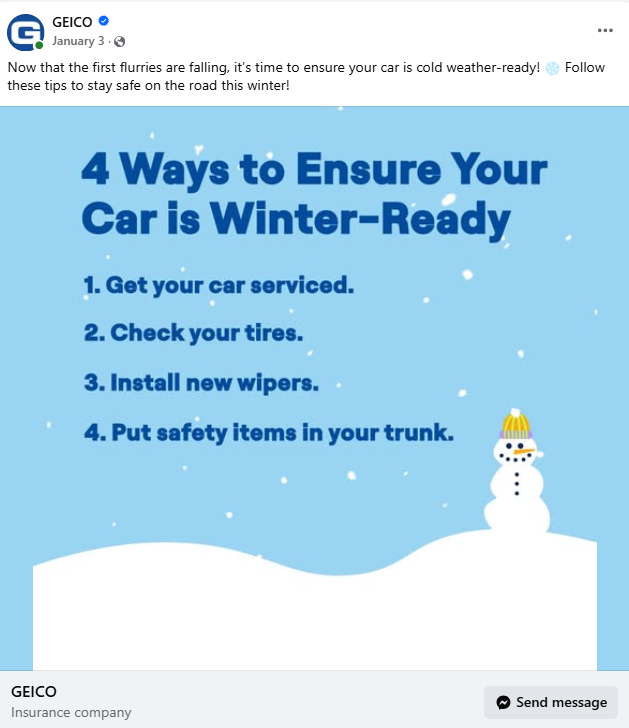How to Promote Your Insurance Agency on Social Media
Social media is a valuable tool for marketing your insurance agency. This top-of-funnel strategy allows you to expand your reach, establish brand awareness and credibility, and discover potential customers.

Successful social media marketing for insurance agents requires well-written and visually pleasing content that gives your brand an authentic voice. It also means posting content consistently and at the ideal time so that you reach and grow your intended audience.
This article will help you:
- Curate an authentic brand voice
- Develop a content schedule
- Post content in the right place
- Post at the right time consistently
- Create unique, engaging posts with strong calls to action
Finding Your Agency’s Authentic Brand Voice
Building an authentic brand voice that represents you and your business is key to getting recognized on social media. When developing social media posts for your insurance agency, create a distinct personality that you also use for all your communications. Here are some questions to help you hone your voice:
- Is your brand voice the life of the party? Do you use emojis in your posts? Do you use humor or puns?
- Is your brand voice about community and elevating others? Do you tag local businesses and promote other organizations?
- Do you use your brand voice to educate and inform? What topics are relevant to your potential clients?
Here are some examples of insurance-related social media posts with clear branding and strong messaging:


In contrast, posts without a brand voice or those that are reshared and feature pre-canned content do not contribute to your brand voice. These posts also tend to generate less engagement due to Facebook’s algorithms.
This article from Hootsuite goes into further depth on building your brand’s voice and social media presence. It covers:
- Researching your audience
- Defining your mission
- Describing your brand personality
- Putting together brand guidelines
- Allowing for differences between platforms
- Testing and tweaking
7 Social Media Strategies for Insurance Agents
1. Post at an Ideal Frequency
Some sources recommend daily posting on your Facebook business page and other social media channels. That may work for some businesses, but in working with insurance agents, we have not found it to be as effective.
Instead, we’ve found that posting 2-3 times weekly is good social media practice for insurance agents.
You can read more detailed recommendations for specific posting cadences geared to individual platforms in this Hootsuite article.
2. Post at the Ideal Times for Each Social Channel
This article from Social Pilot gives in-depth recommendations for ideal posting times. Here is a summary of their findings:
- Facebook: Early mornings, lunchtime, and early evenings on weekdays
- Instagram: Midday and evenings on weekdays and afternoons on weekends
- LinkedIn: Weekday mornings and early afternoons are generally ideal for business content
- X: Midday on weekdays is often best for quick, engaging content
- TikTok: During lunch breaks and in the evening hours
You may want to run tests and experiment with different times to see which gets you the most engagement.
3. Create a Content Schedule in Advance
Planning your social media content in advance will:

- Ensure consistent posting
- Reduce the stress of drafting last-minute posts
- Support well-written and engaging content
As you create your calendar, consider these steps:
- Brainstorm topics
- Choose the right format
- Establish a posting frequency
- Match content to the appropriate platforms
- Design standout social media posts
- Schedule your posts strategically
- Analyze content performance
This article from Planable goes into more detail and offers a free calendar template for your content. As you go through step #5, keep in mind that different types of content will perform better on specific social platforms. Ensure you’re posting content that caters to each platform’s strengths and audiences. Posting on LinkedIn probably won’t get you personal lines clients, but because it is a business platform, it might get you commercial leads.
Here are some general guidelines for which type of content will play best on each of the major platforms:
- Short-form video (Reels)
- Stories
- High-quality images
- Carousels
- User-generated content
- Behind-the-scenes content
- Live video

- Long-form text posts (articles)
- Infographics
- Professional photos
- Carousel posts
- Short video content
- Industry insights and thought leadership content
- Short-form video
- Live video
- Images
- User-generated content
- Text-based posts (for discussions)
Twitter (X)
- Short, concise text posts
- Images
- GIFs and memes
- Polls
- Short video clips
TikTok
- Short-form video (15-60 seconds)
- Trending audio and challenges
- User-generated content
- Behind-the-scenes content
5. Include a Call to Action
A Call to Action (or CTA) is part of a website, advertisement, or piece of content that encourages the audience to act. Calls to Action take many forms:
- A “Call Now” or “Message” button on a Facebook post or a Facebook ad
- A saved text message signature for all your texts with a link to your website or a “Text or call me now for an auto and home quote” message
- A link to get a quote on your website
Treat social media marketing as a strategy to grow your audience. You want to build up a presence by demonstrating your value without pushing a hard sell. A CTA could be a link to an article you’ve written or an important statistic related to your business. You could invite people to respond to a poll or share their home disaster stories. Experiment with different and creative ways to get people engaged.
6. Create Unique Posts

You want your brand to stand out and be easily recognizable. Avoid purchasing images or using free online photos from sites like Unsplash or Pixaby, if possible.
Have some agency-branded gear made and take photos, make videos, and create infographics or other images. You can use online software like:
There are thousands of image, meme, or gif generators available online. Find the tools that inspire you most.
7. Write Good Copy
There is no magic button for writing good content. However, by trying varied approaches and following best practices, you can write posts that users will want to engage with. Remember to always incorporate your brand voice, use unique images and videos, and speak to your target audience.
Here are some tips and best practices when writing social media copy for insurance:
- Avoid the “wall of text”. Posts should be visual and not word-heavy. Keep messages short and sweet, and stick to one idea per post. For longer posts, such as a LinkedIn article, use bullet points, emojis, or headers to highlight key points.
- When creating helpful content, ensure it genuinely benefits your target audience.
- When possible, trigger your audience’s emotions. For instance, nostalgia is also a good way to reach your audience.
- Offer incentives—consider gift cards for quotes, free branded gear, giveaways, etc. These can make for good visual posts and also generate engagement.
8. Leverage Video
Short videos, especially User-Generated Content (UGC), have quickly become one of the most effective ways to attract attention to social media posts. If you can create brief but compelling video content around insurance topics, you stand a good chance of stopping users who would otherwise scroll past your post.
Here are nine best practices to keep in mind when creating your videos:
- Capture Attention Quickly: A hook in the first few seconds is crucial.
- Keep It Concise: Aim for a length of 30 to 60 seconds.
- Break-Up Topics: If your content is complex, create a series of shorter clips.
- Film in Portrait Mode: Most users view content on mobile devices.
- Use Dynamic Pacing: Varying lengths and speeds maintain viewer interest.
- Add Captions and Text Overlays: Many viewers watch videos without sound, so make sure your words reach them via multiple formats.
- Incorporate Music and Sound Effects: These can enhance emotional impact and help for your content to show in various algorithms/feeds.
- Include a Clear CTA: Suggest that your users contact you, learn more, or leave a comment depending on the post type.
- Analyze Performance: Monitor how your videos perform and refine your strategy.
Grow Your Agency with the Right Social Media Content and Partner
Hopefully, we’ve shown you how to market your insurance agency on social media. If you’re just starting your insurance business and looking for ways to grow your agency, Firefly can help. We match independent insurance agents with the carriers that help you close more sales. We’ll help you find your market and build your book of business without the hefty startup fees that cripple small enterprises. With Firefly’s money-back guarantee, you have nothing to lose.
Contact us today to learn more.